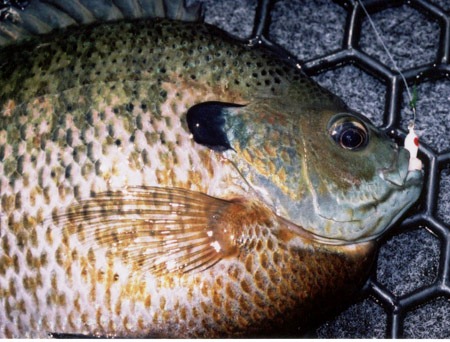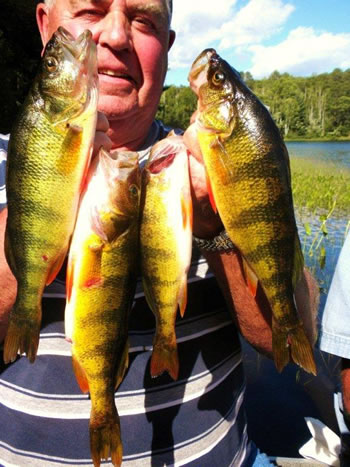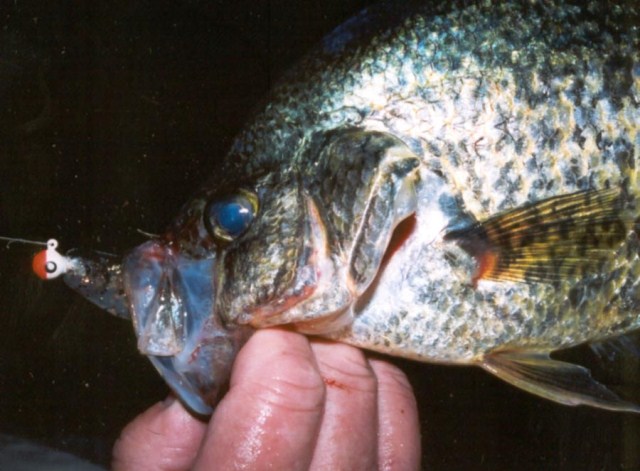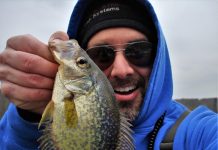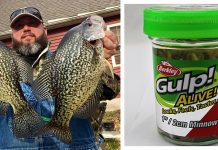Its summer and the thermometer and water temperatures are both heating up, many of are local lakes are finally getting weedy, and the Wisconsin River is running high and dirty. So, where does an angler go to catch some fish? Here is a good way to beat the mid summer slow-down and catch some tasty panfish in southern Wisconsin and most waters in the Upper Midwest.
Early in the fishing season it’s easy to catch most fish species and especially panfish in water less than 10 feet deep. Initially after ice-out, panfish and most fish are attracted to the warmth of the shallows after a cold winter and a period with a slow metabolism. The shallow water is where the food chain gets started with the first hatches of insects and zooplankton. This, coupled with the warmer water temperature brings in the fish. Many of the fish also will lay their eggs and spawn in the shallow water of most Wisconsin and Upper Midwest lakes. The first weeds of the year are finally growing giving cover and food to the young fry that have just hatched. During the first two months of the fishing season, it’s possible to find most panfish fish shallow and often you’ll have fish species all in the same shallow water locations.
But, now things have changed with the advent of summer and its warm weather. Most if not all fish have spawned and now have moved or are starting to move to their summer haunts. As we get into the warmer months of July, August, and early September fishing can be downright difficult. What really has happened is that many of the panfish (crappies, perch, white bass, bluegills) and most gamefish (walleyes, northern pike, smallmouth bass, largemouth bass, and muskies) have moved away from the warmer and shallow water to scattered mid-lake locations and deep weed lines. There, the water is cooler and more in their specific “comfort zone.” There needs to be zooplankton close by and often suspended throughout in the water column. These locations can be about anywhere in the lake, but mid-lake structures like rock piles, humps, cribs, underwater islands, and deep-water weeds are always worth checking out along with the lake’s main basin. Fish and schools of panfish constantly roam around a lake, especially a mesotrophic lake, chasing and feeding upon the tiny zooplanktons that are moved by the wind currents. Zooplankton can move vertically or up and down in the water column, but they need wind to move them horizontally and around the lake. Often, you’ll see clouds of zooplankton (bugs) rising off the bottom of a lake and scattered up and down from the bottom to the lake’s top on your Lowrance electronics. These “clouds or balls” of baitfish and zooplankton are what you’re looking for and ideally is where you want to be fishing. This is why one needs quality electronics like those from Lowrance or Hummingbird to see the forage or food (zooplankton) that’s suspended. Initially, I suggest that you slowly motor over the areas that you intend to fish with your eyes “glued” to your electronics while looking for the schools of baitfish. The key is to find the food and then you’ll find fish in the immediate area. Besides the need for good electronics, pick up a map of the waters that you plan to fish or use a website like Fishidy to do some research before you hit the water.
There are good two tactics for panfishing during the summer and early fall. One way is to drift fish across the main basin of a lake with its structure or fish the lake’s deep weedlines. Depth is a relative thing depending on the waters that you’re fishing. The types of lakes that I’m fishing are mainly mesotrophic lakes which are found in much of Wisconsin and the Upper Midwest. Mesotrophic lakes are commonly relatively clear with submerged aquatic plants and vegetation or weeds and a medium level of nutrients.
When drifting for panfish during the heat of summer, remember that the wind is your friend. As I earlier mentioned, the wind is what moves the zooplankton or small organisms around the lake. Before fishing and after looking at a map, see which direction the wind blew from the day before. This can greatly help your fishing success by telling you the general locations where you want to drift. Panfish drifting can be much like trolling for open-water trolling for walleyes, where it’s important to cover as much water as possible till you find the forage and then the fish. If you had a south wind the day before, then you want to be fishing and drifting the northern areas of the lake because that’s where the feed will have been blown to.
A lake that I fish often is Madison’s Lake Monona which is a highly productive lake for most fish with a maximum depth of over 60 feet. It has good structure, weeds, and a river flowing in and out. Its main basin is perfect for a summer drift for perch, crappies, white bass, and even bluegills. Though bluegills are a weed orientated fish and near-sighted, they too can be caught while drifting a lake’s main basin. What happens to Lake Monona and many lakes in the North Country is that during the warm and hot weather the water where fish will be actually compresses or gets smaller. Most lakes with the exception of shallow lakes, like huge Lake Winnebago, experience stratification where you have different temperatures and oxygen levels at different depths in the summer. Lake Monona’s fish will usually suspend anywhere from 5 to 20 feet down in water that is 40 feet deep and sometimes even deeper. Again, good electronics can show you a lake’s stratification and you should always be fishing above this level. Once you find the zooplankton and see the stratification, you should be in for some quality fishing.
The equipment and gear that you need for panfish drifting is simple and doesn’t have to be expensive. The first thing that you need is a long rod between 7 and 7 ½ feet long (G. Loomis, Fenwick, and Berkley) make good ones with an extra fast or fast tip. Combine this with a quality ultra-light reel (Shimano or Daiwa) spooled with 4 pound Trilene monofilament. Then, I tie a barrel swivel to the main line and to the swivel I add 2 to 3 feet of fluorocarbon line and then tie on a 1/32 ounce jig like the Bait Rigs Slo-Poke jig which I’ve found to work well for all panfish and even the occasional walleye or bass. The Slo-Poke jig falls better horizontally than most other jigs that I’ve tried. Try to have an assortment of colors with glow and chartreuse working well in most lakes. But, keep experimenting till you find what works that day! The jig is then loaded with 3 or 4 spikes, wax worms, or leaf worms and weighted with split shots. I use the smaller split shots (1/32 ounce) to weight the line spacing them 2 to 3 feet above the jig. This is not a precise method, but it works well. Since Wisconsin allows you to use 3 rods, I’ll weight my lines with a different number of split shots (2, 3, or 4) and count out the amount of line let out by the number of line pulls. Experiment with adding and deleting split shots till you find active fish. Be sure to keep your eye on your rod tips for bites. Often when drifting, the fish will hook themselves. You want to scatter you baits up and down in the water column above the thermocline and stratification. It’s much easier to fish and drift, if you have rod holders (Scotty or Tempress) on your boat. What you’re really trying to do is to “rake” the water column for your fish.
While fishing this “system,” I’ve found that the bluegills are always the highest up in the water, the crappies are normally below the bluegills, and the perch are almost always the deepest fish that you’ll find. White bass can be scattered anywhere from top to bottom of most waters.
You don’t have to get on the water early for this bite. Panfish are sight feeders and the best action is from 10 am to 2 pm when the sun is at its highest point in the sky giving the greatest light penetration. One other tip, if it’s too windy for drifting try using a drift sock to slow you down. They are worth the investment!
The other tactic or technique that catches summer panfish is to fish deep weeds lines. Again, this technique is different because I’m fishing locations that I know hold fish some time during the day. You won’t always see on your electronics because the fish are often are buried in the weeds waiting to ambush whatever comes by. This method requires a good anchor and plenty of rope. Anchor up in a good spot and fish the weeds that the wind is blowing into with a small jig (the Bait Rigs Cobra works great) in the # 12 size and a slip float. The wind will give your bait movement, action, and blow it toward the weeds. It’s very important to position your boat in a location where you’re not on top of the fish and have to make a long cast to them. The panfish can be anywhere in the weeds or close by them. The weeds that you’re looking for are; coontail, cabbage, and sand grass in most lakes in the north. Some days, a plain Aberdeen hook (# 8) and a split shot or two is all you need with live bait. Since you can use three rods try to rig them with different kinds of bait, different colors, and fish them at different depths to again cover the water column. Fish an area for a half an hour before moving and when you move make small moves looking for open areas in the weeds and any inside turns. You want to move small distances, so often all you have to do is let out a little more rope. This should be a location that you know and have confidence in, so the panfish might be only a cast away from you.
These are tried and true methods for catching panfish in summer and fall’s hot weather. I was turned on to these tactics by Madison’s panfish guru, Dr. Drift or Joe Puccio. Joe is an excellent angler and panfish is his forte. If you have a good size lake which warms in the summer and fishing is tough give one of these techniques a try.

